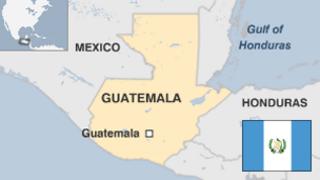Home » Latin America »
Guatemala country profile
Guatemala is still trying to come to terms with a 36-year-long civil war.
The conflict, which ended in 1996, pitted leftist, mostly Mayan insurgents against the state, which – backed by the US – waged a vicious campaign to eliminate the guerrillas.
More than 200,000 people – most of them civilians – were killed or disappeared.
It is a country of striking features and a strong indigenous culture. It is mountainous, forested and dotted with Mayan ruins, lakes, volcanoes and orchids.
The indigenous Maya make up about half of the population but rights campaigners say they face extreme inequality.
The country is a major corridor for smuggling drugs.
FACTS
Republic of Guatemala
Guatemala City
Population 15 million
Major languages Spanish, more than 20 indigenous languages
Major religions Christianity, indigenous Mayan beliefs
Life expectancy 68 years (men), 75 years (women)
Currency quetzal
LEADER
President: Jimmy Morales
Jimmy Morales, a political newcomer, was elected president of Guatemala with 72% of the vote in run-off polls held in October 2015.
A former TV comedian with no experience in government, Mr Morales defeated the former first lady, Sandra Torres, who is seen by many as part of the country’s unpopular political elite.
The election took place a month after the resignation and arrest of President Otto Perez Molina, who was accused of leading a corrupt network of politicians and customs officials.
In 2017 prosecutors sought to open an investigation against President Morales over alleged campaign funding irregularities.
MEDIA
Journalists who expose corruption among politicians and officials face threats and violence, say press freedom watchdogs.
Privately-owned outlets dominate the media. Ownership is highly concentrated, especially in the TV industry.
TIMELINE
Some key dates in Guatemala’s history:
1821 – Guatemala, under Spanish rule since 1524, becomes independent.
1839-1944 – The country sees a series of dictatorships with brief interludes of constitutional legitimacy.
1944 – Start of 10 years of democracy. President Juan Jose Arevalo undertakes major social reforms and Colonel Jacobo Arbenz, who succeeds him, launches land reform and nationalizes the property of US companies.
1954 – Coup brings Col Carlos Castillo Armas to power, with the backing of the CIA. His regime is marked by repression and the emergence of the first death squads.
1960-1996 – Civil war begins after a far-left guerrilla movement, inspired by the Cuban revolution, emerges and is promptly followed by a far-right counter-guerrilla movement.
1963 – Elected president Gen Miguel Ydigoras Fuentes is overthrown. A series of coups follows, with regimes dominated by the armed forces and marked by atrocities by the far right.
From 1979 the country will witness assassinations, massacres and disappearances throughout its territory.
1982 – Gen Efrain Rios Montt takes power after a coup, installs military tribunals and launches “scorched earth” counter-insurgency campaign to wipe out guerrilla support in heavily-Indian provinces. An estimated 626 Indian villages are annihilated under the “scorched earth” offensive.
1986 – Return of civilian rule.
1996 – Government and guerrillas sign a peace accord focused mainly on the recognition as full citizens of indigenous Guatemalans and the bolstering of civilian power to the detriment of the army.
1999 – A truth commission blames military for 93% of all massacres, tortures, disappearances and assassinations during the war which left 200,000 dead and disappeared.
Source: Read Full Article



